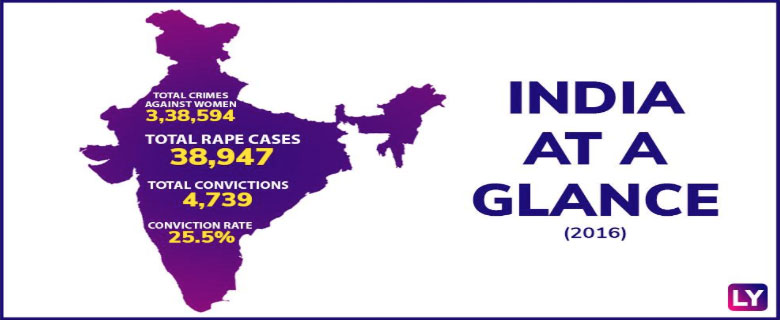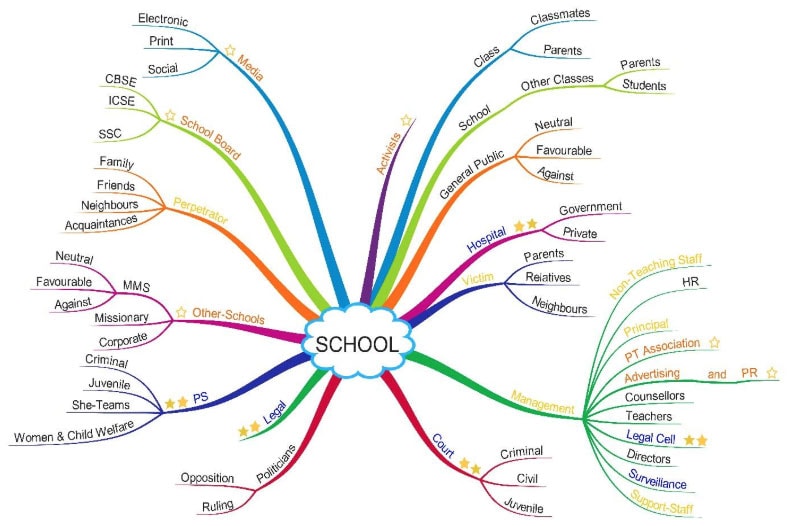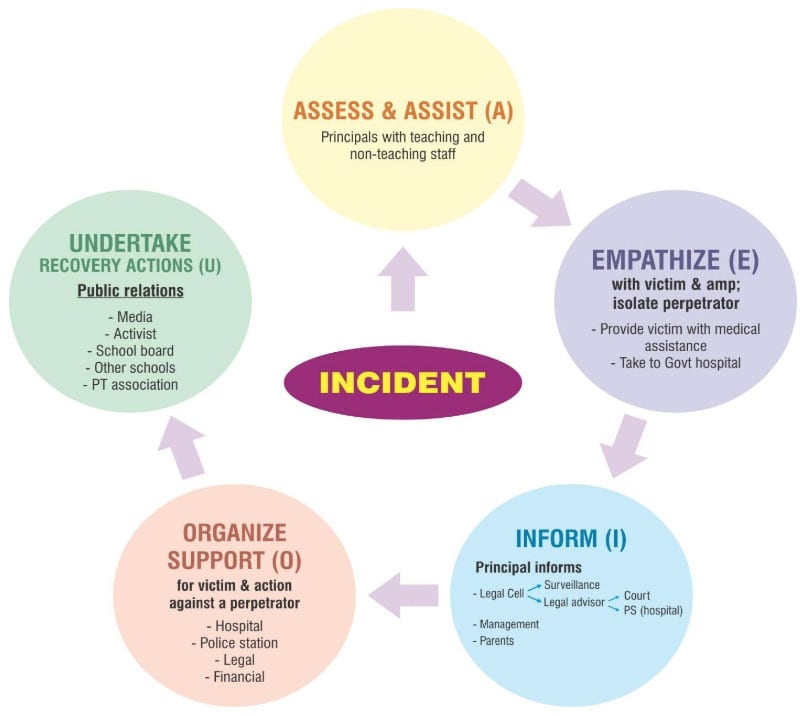Violence is a term for wide range of violations, which consist of both the physical and the sexual, ranging from sexual assault in society to sexual abuse. The subject of sexual violence is still a taboo in India. In spite of numerous incidents people are still not comfortable talking about it. There is a conspiracy of silence around the subject, a sizable majority fell it is largely a western problem, the general belief that child abuse doesn’t happen in India and many a time such cases are brushed under the carpet.
In India, rape is the fastest growing crime and reports indicate that rape of women and young girls in India has increased considerably especially in recent years.
Recent statistics about sexual violence

According to the National Crime Records Bureau in India (NCRB), there has been a startling increase of 873.3 percent in the number of rape cases registered in India from 1971 to 2011 (The Times of India, Dec 27, 2012).
A study in 2011 estimated 7.9% of males and 19.7% of females universally faced sexual abuse before the age of 18 years.
India has the world’s largest number of CSA cases: For every 155th minute a child, less than 16 years is raped, for every 13th hour child under 10, and one in every 10 children is sexually abused at any point of time.
A total of 26,694 cases of sexual abuse in children were reported in the nation during the year 2010 and 33,098 cases reported in 2011.
After Nirbhaya case reported the cases jumped by a massive 26% in 2013, the highest in the last 15 years
According to the report on crimes in India for 2016 – 106,958 cases of crimes against children were recorded.
What is sexual violence
Violence has many causes, including frustration, exposure to violent media, violence in the home or neighborhood and a tendency to see other people’s actions as hostile even when they’re not. Certain situations also increase the risk of aggression, such as drinking, insults and other provocations and environmental factors like heat and overcrowding.
The term “sexual violence” is an all-encompassing, non-legal term that refers to crimes like sexual assault, rape and sexual abuse. Sexual violence is a serious public health and human rights problem with both short- and long-term consequences on women’s physical, mental, and sexual and reproductive health. Sexual Assault can happen to anyone, anywhere, at any time.
Types of sexual violence
Sexual Assault: Forcing a person to participate in sexually related acts even though he/she is unwilling. It is believed that sexual assaults are not motivated by the offender’s desire to have sex, but as a vehicle for the offender to fulfill a need for control and power. To this extent, the offender frequently tends to use a mixture of coercion by physical force, verbal threat intimidation and even placing blame on the victim in order to perpetrate the attack. Any sexual activity with a minor also constitutes sexual assault.
Sexual Abuse: it is unwanted sexual activity, with perpetrators using force, making threats or taking advantage of victims not able to give consent. Most victims and perpetrators know each other. Immediate reactions to sexual abuse include shock, fear or disbelief. Long-term symptoms include anxiety, fear or post-traumatic stress disorder.
Sexual Assault of men and boys: Research has found that 1 in 6 men have experienced unwanted or abusive sexual experiences before the age of 18. The commonly reported number of 16% of males experiencing abuse is grossly underestimated because males who have such experiences are less likely to disclose them than females. Perpetrators can be any gender identity, sexual orientation, or age, and they can have any relationship to the victim
Incest: incest is sexual contact between persons who are so closely related that their marriage is illegal (e.g., parents and children, uncles/aunts and nieces/nephews, etc.). This usually takes the form of an older family member sexually abusing a child or adolescent.
Sexual Harassment / Stalking: Sexual harassment is when someone: touches you or asks you to touch them in private parts even if it is over the clothing; shows you sexual pictures or objects that make you feel uncomfortable; talks about sexual things or tells you dirty jokes; makes you feel uncomfortable at school, work, or at play; doesn’t stop when you ask them to. If you are having trouble with an individual sexually harassing you, there may be zero tolerance policies about sexual harassment at your school or workplace. Stalking is defined as a course of conduct directed at a specific person that places a reasonable person in fear for her or his safety
Drug-Facilitated Sexual Assault: Performing any sexual act(s) on a person who is unconscious or asleep, too drunk to withhold consent, or unable to communicate. The victim usually blacks out, and has no memory of the assault or the events surrounding the assault
Sexual violence in schools
Schools play a highly important role in socializing children and young people about gender relations and sexuality. According to the findings, violence occurs mostly in classrooms, on sports fields or in bathrooms with signs of hair-pulling, kicking, verbal threats and pupils touching another inappropriately.
Sexual violence at schools are not limited to the students but the teachers and grade 4 employees working at the school
When education environments are hostile due to sexual harassment, assault, or violence, students cannot learn and end up missing out on true educational opportunities. American Association of University Women (AAUW) own research revealed that two-thirds of college students experience sexual harassment and nearly half of students in grades 7–12 face sexual harassment. In addition, many studies have found that a good number of women are targets of attempted or completed sexual assault while they are college students.
School-based sexual violence prevention and redressal program
Three way Approach
Identification: this include comprehensive analysis of identifying the target segment or the victim, the prone areas where the incident can take place the perpetrator and also defining the types of abuses including the verbal and nonverbal abuses
A. Target Segments
- Girls
- Boys
- Teachers
- Support staff
Perpetrator
- For students – Attenders, Male Teachers, Bus or Auto Drivers, Peers and seniors
- For staff – Male teachers, Male principals, Attenders and Drivers
Specified Areas
- Blind spots
- Toilets & surrounding areas
- Classroom (Empty; at end of corridors, top floors)
- Staff Rooms
- Store Rooms
- Janitor rooms and
- Pantry
Abuses
- Verbal- Filthy language, Double meaning word, Use of slangs, in appropriate Comments & gestures
- Non-verbal – Unhealthy gaze, stalking, abuse, inappropriate touches.
B. Preventive Education: preventive measures can be taken up by educating the people and train them in handling or avoiding the risky situations.
For Pre-primary and primary students the awareness should be given on knowing who they are, knowing themselves their responsibilities and making them understand the idea of being brave v/s being stupid, how media has its effects and train them on How to behave with strangers and known people, importance of buddy system and avoiding the Areas in school to be avoided at all times, and Behavioral training should be provided to make then understand what is appropriate behaviors and how to avoid inappropriate behaviors in buses, autos and in public transport.
For middle and high school students the training and education focuses on Hygiene, Gender sensitivity, Changes at adolescent’s stage along with the awareness program and Educating on use of social media.
For Teachers the training should be given on how be confidant and assertive, No nonsense attitude to be exhibited, How to maintain defined distance and Not exceeding the time to stay back beyond official hours except in emergency and in such situations should request colleague for company.
And for Grade 4 employees training should be given on when working in pantry or janitor rooms no opposite gender should be allowed, avoid gossiping and interaction with other genders and the management should assign work of areas to one gender group at a time.
C. Post Incident Handling: Post incident handling includes the identification of the people involved in the incident and the role of each in short term and long term handling of the situation after the incident has taken place.
Post incident handling
Approach 1:
Get into a defensive mode and say nothing has happened here. Deny every allegation. Say it’s not just our responsibility and that the parents are also equally responsible.
(Most schools hesitate to face the problem and get into the defensive mode. They stress that the school is clean, safe and secure and nothing of that sort happened here.)
Approach 2:
It’s the image of the institution that matters most and hence get into the image protection mode. All your efforts are focused on creating a better image, right from addressing the needs of the issue to caring for the victim etc.
(This stands on the belief that parents don’t sent their wards to school because it is clean or no allegation on it. They send because the image is good, such incident damage the image and hence should be protected, this is the general perception)
Approach 3:
The reality is the school should live by certain values that value is to take care of every individual that comes to the school. And hence irrespective of where and when the incident takes place the school feels responsible and puts all its efforts in safeguarding the victim from every possible pain, both physical and emotional
Anecdotes
Suicide in Residential school:
The management comes to know about the incident at 04:00 am in the morning and by 04:30 the management was there at the school. Took control of the situation led the morning prayers and assembly continued without interruption; but the process of managing the situation continues.
- They informed the police
- Took the body to the hospital
- Informed the family
- Held counselling session with staff and students
The impact of the suicide was not felt at the school. The children were counseled and made them focus on their daily routine.
On the premises a specific code of conduct was imposed, right from the principal to the grade 4 employees. The situation was eventually managed properly.
Health Emergency
A student suddenly collapses on the ground during assembly. The class teacher along with the head teacher take her to the nearest room and provide medical assistance. She is accompanied by her close friend, the condition worsens and the management arranges an ambulance and then the parents are informed.
The condition of her health slowly improves and the identified reason was because she did not have breakfast in the morning. The school management did not blame the parents but took complete responsibility of providing medical help when needed most and the school functioned interrupted.
Who All Gets Effected By the Incident

The AEIOU Model

Post incident handling flowchart
After the incident takes place the principal along with the staff comes into action of assessing and assisting the people. They will empathize with the victim by proving the immediate medical assistance and also isolate the perpetrator in a closed room and takes the charge of controlling the people. After which the principal will inform the legal cell for surveillance help and legal advisor will take charge of managing informing the police and the hospital. The principal will inform the management and the parents of the victim.
The management will help in providing or organizing the support for victim which can be in the form financial, medical or legal
Simultaneously public relation officer will deal with the media, activists, school board, other schools and parent teachers association. And all the concerned that are in some way or the other relate and matter to the incident.
Dr. Azra Fatima
Consultant Clinical Psychologist
Islaah Center for Psychological Wellness (Adivision of LEARN Maximum)
